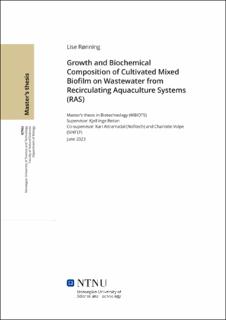| dc.description.abstract | Bruken av Resirkulerende akvakultursystemer (RAS) for å produsere atlantisk laksesmolt (Salmo salar) har økt de siste årene. Med økningen har det imidlertid også blitt uttrykt bekymringer angående miljøforurensningen knyttet til avløpsvann fra akvakulturindustrien. RAS vann inneholder betydelige mengder inorganisk nitrogen og fosfor som kan påvirke de lokale økosystemene. Opphopning av nitrogen og fosfor i RAS kan også utgjøre en potensiell trussel mot fisken, og må behandles slik at ikke giftige nivåer nås. Samtidig utgjør nitrogen- og fosfor mangel en betydelig global trussel, da fiksering av nitrogen fra atmosfæren er ansvarlig for 1% av energiforbruket og 1,4% av CO2- fotavtrykket på global skala. «Peak phosphorous» teorien beskriver hvordan verden vil gå tom for fosfor ved slutten av dette århundre, som utgjør en alvorlig trussel mot verdens matsikkerhet.
Målet med denne studien var å adressere utfordringene knyttet til håndtering av næringsstoffer i RAS, som utgjør en lokal bekymring, samtidig som nitrogenmangel representerer et globalt problem. Ved å dyrke mikroorganismene som naturlig finnes i RAS vann som biofilm i en bioreaktor, kan dette systemet utnytte næringsstoffene i RAS vannet og samtidig bidra til vannrenseprosessen. I tillegg kan biofilmproduktet høstes og brukes som mulig fôringrediens eller gjødselkomponent på grunn av den verdifulle biokjemiske sammensetningen assosiert med mikroalger. Formålet med denne studien var å bidra til utvikle av et vekstsystem for mikroorganismer i RAS-vann fra Hardingsmolt AS. Viktige faktorer som påvirket utviklingen og dyrkingen av biofilmen ble karakterisert. I tillegg ble den biokjemiske sammensetningen i biofilm produktet, produsert under forskjellige høstfrekvenser, bestemt og sammenlignet med biomassene fra en pilotstudie utført på Hardingsmolt RAS anlegg.
Et sentralt funn var at fotoautotrofe organismer dominerte biofilmkonsortiet, noe som indikerer at lys er en viktig faktor for dyrkingen. Videre økte biomasseutbyttet og produktiviteten betydelig med tilsetning av silikat til RAS-vannet, opprettholdelse av høy næringskonsentrasjon og høsting av biofilmen hver 12. dag. Den biokjemiske profilen til biofilmproduktet under påvirkning av forskjellige høstfrekvenser (4 dager, 8 dager, 12 dager) ble karakterisert. Betingelsen med 12 dagers høstfrekvens hadde en signifikant høyere verdi innenfor total protein (363 mg g-1 DW), carbon og nitrogen innhold og sum ikke-essenielle amino syrer (208 mg g-1 DW). Når biofilmproduktet fra laboratoriet ble sammenlignet med produktet fra pilotreaktorene ble det ikke funnet signifikante forskjeller. De verdifulle flerumettede fettsyrene: eikosapentaensyre (EPA) og dokosaheksaensyre (DHA) var til stede i alle gruppene, der 12 dagers høstfrekvens hadde et noe høyere, men ikke signifikant, høyere innhold. Også høye nivåer av palmitoleinsyre ble funnet i alle gruppene.
Resultatene fra denne studien demonstrerte en vellykket dyrking av biofilm på mikroorganismer fra RAS vann (Hardingsmolt AS). Biofilm produktet ble anerkjent som en lovende komponent både for behandling av RAS vann og som en potensiell ingrediens i fôrproduksjon. | |
| dc.description.abstract | There has been an increase in the use of Recirculating Aquaculture Systems (RAS) to produce Atlantic salmon smolts (Salmo salar). However, concerns have been raised regarding the environmental pollution associated with aquaculture wastewater. RAS water contains substantial amounts of inorganic nitrogen and phosphorous which can impact the local ecosystems. Nitrogen accumulation in RAS can also pose a potential threat to the fish and need to be treated before reaching a toxic level. Meanwhile, nitrogen and phosphorus deficiency pose a global threat, as binding nitrogen from the atmosphere is responsible for 1% of the energy consumption and 1.4% of the CO2 footprint on a global scale. Also, the “peak phosphorous” theory describes how the world will be depleted of phosphorous within the end of the century, posing a serious threat to the worlds food security.
The present study aimed to address the challenge of nutrient management in RAS. By cultivating the microorganisms present in the RAS water as a mixed community biofilm in a bioreactor, this system can utilize nutrients in the RAS water, thus contributing to the water treatment process. Additionally, the biofilm product can be harvested and utilized as a potential feedstock or fertilizer ingredient due to the valuable biochemical composition associated with microalgal biomass. This study therefore aimed to develop a growth system for this mixed biofilm of microorganisms present in the RAS water from Hardingsmolt AS. Important influencing factors for biofilm development and cultivation was determined. Additionally, the biochemical composition of the biomass produced under different harvest frequencies, was determined, and compared to the biomass obtained in a pilot study on-site at Hardingsmolt AS.
Photoautotrophic organisms were found to dominate the biofilm consortium, indicating light as an important factor for cultivation. Further, the biomass yield and productivity significantly increased with the addition of silica to the RAS water, keeping a high nutrient concentration, and harvesting of the biofilm every 12 days. The biochemical profiles of the biofilm product under the effect of different harvest frequencies (4 days, 8 days, 12 days) were characterized. The 12 day harvest frequency condition had significantly higher values for total protein (363 mg g-1 DW), nitrogen, and carbon contents and sum non-essential amino acids (208 mg g-1 DW). When the biofilm product obtained in the lab was compared to the one from the on-site pilot reactors, no significant differences was found. The valuable polyunsaturated fatty acids, eicosapentaenoic acid (EPA), and docosahexaenoic acid (DHA) was both present in all groups, where the 12 day harvest frequency had somewhat, but not significantly, higher contents of both DHA and EPA. High levels of palmitoleic acid were also found in all three conditions.
The results obtained in the present study, demonstrated the successful cultivation of mixed community biofilm from RAS water (Hardingsmolt AS), which was recognized as a promising component in both RAS water treatment and as a potential feedstock ingredient. | |
